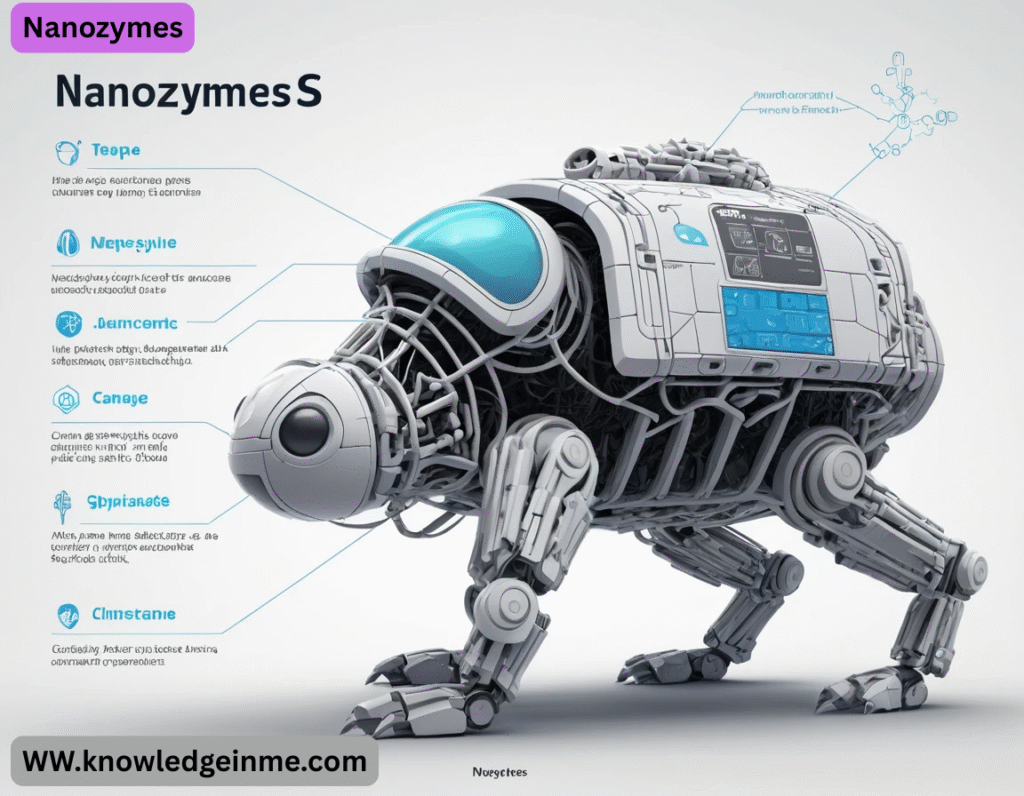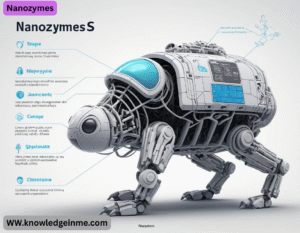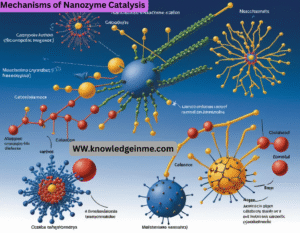Nanozymes Nanozymes are nanomaterial-based artificial enzymes that mimic the catalytic functions of natural enzymes. They combine the unique properties of nanomaterials (e.g., high stability, tunable activity, and low cost) with the catalytic efficiency of enzymes. Since their discovery in 2007 (FE₃O₄ nanoparticles with peroxidase-like activity), nanozymes have emerged as promising alternatives to natural enzymes in biomedical, environmental, and industrial applications.
Key Features of Nanozymes
Enzyme-Like Activities
- Mimic oxidases, peroxidases, catalases, superoxide dismutases (SOD), hydrolases, etc.
- Example: CEO₂ nanoparticles exhibit SOD-like activity, scavenging reactive oxygen species (ROS).
- Advantages Over Natural Enzymes
- Higher stability: Resist harsh conditions (pH, temperature).
- Cost-effective: Easier synthesis than protein-based enzymes.
- Tunable activity: Size, composition, and surface modification alter catalytic properties.
Multifunctionality
- Some nanozymes possess multiple enzyme-like activities (e.g., V₂O₅ nanowires with peroxidase-, oxidase-, and phosphatase-like actions).
Types of Nanozymes
Nanozymes are classified based on their composition:
- Metal-Based (e.g., Au, Pt, FE₃O₄ nanoparticles).
- Metal Oxide-Based (e.g., CEO₂, MNO₂, CO₃O₄).
- Carbon-Based (e.g., graphene oxide, carbon dots).
- MOFs/COFs (Metal-/Covalent-Organic Frameworks).
Applications of Nanozymes
Biomedicine
- BIOSENSING: Glucose detection (using peroxidase-like nanozymes).
- Antioxidant Therapy: CEO₂ nanozymes for ROS scavenging in neurodegenerative diseases.
- Antimicrobial Agents: ROS generation to kill bacteria (e.g., AU@PT nanozymes).
- Cancer Therapy: Catalytic generation of cytotoxic ROS in tumors (chemo dynamic therapy).
Environmental Remediation
- Degradation of pollutants (e.g., organic dyes, pesticides) via peroxidase-like activity.
- Detection and removal of heavy metals (e.g., Hg²⁺).
Industrial Catalysis
- Replacement of natural enzymes in biofuel production, food processing, and wastewater treatment.
Agriculture
- Nanozyme-based sensors for pesticide detection.
- ROS modulation for plant stress resistance.
Challenges and Future Directions
- Selectivity: Improving substrate specificity to match natural enzymes.
- Biocompatibility: Reducing potential toxicity for clinical use.
- Standardization: Developing uniform characterization methods.
- Multienzyme Systems: Designing cascades (e.g., glucose oxidase + peroxidase mimics).
Mechanisms of Nanozyme Catalysis
- Nanozymes mimic natural enzymes by facilitating reactions through similar mechanisms, often involving active sites, electron transfer, and reactive oxygen species (ROS) generation.
Synthesis Methods of Nanozymes
- Nanozymes are synthesized via physical, chemical, and biological methods, with control over size, shape, and surface chemistry to optimize activity.
Chemical Synthesis
- Co-precipitation: Simple, scalable (e.g., FE₃O₄ NPs).
- Solvothermal/Hydrothermal: High crystallinity (e.g., CEO₂ NPs).
- Reduction Methods: For noble metals (e.g., Au, Ag NPs via NABH₄ reduction).
Green Synthesis
- Plant extracts/biomolecules as reducing agents (e.g., Au NPs using tea extract).
- Microbial synthesis: Bacteria/fungi produce metal NPs.
Surface Modification
- Ligand conjugation (e.g., PEG for biocompatibility).
- Doping (e.g., N-doped graphene for enhanced POD-like activity).
Advanced Applications Beyond Conventional Uses
Nanozyme-Enabled Nanomedicine
Cancer Therapy:
- Chemo dynamic Therapy (CDT): Fe-based nanozymes convert H₂O₂ into •OH in tumors.
- Photothermal-Enhanced Catalysis: Au NPs + near-infrared light for synergistic killing.
Neuroprotection:
- CEO₂ nanozymes reduce oxidative stress in Alzheimer’s disease.
Environmental & Energy Applications
Water Purification:
- FE₃O₄ nanozymes degrade organic pollutants (dyes, pesticides).
Antibacterial Coatings:
- Ag-CUO nanozymes on surfaces for hospital-acquired infections.
Battery & Fuel Cells:
- MNO₂ nanozymes improve oxygen reduction reaction (ORR) efficiency.
Agri-Food Applications
Pesticide Detection:
- Nanozyme-based sensors for organophosphate residues.
Food Preservation:
- ZNO nanozymes inhibit bacterial growth in packaging.
Current Research Frontiers
Single-Atom Nanozymes (SANs)
- Maximized catalytic efficiency (e.g., Fe-N-C mimics natural HEME enzymes).
- Used in tumor therapy and BIOSENSING.
DNA-Enhanced Nanozymes
- DNAZYMES + nanozymes for ultra-sensitive detection (e.g., Ebola virus RNA).
Nanozyme Cascades
- Multi-enzyme mimics (e.g., GOX + POD-like nanozymes for glucose detection).
AI-Designed Nanozymes
- Machine learning predicts optimal compositions (e.g., high-activity PTFE alloys).
Nanozyme Catalytic Mechanisms: Beyond the Basics
Electron Transfer Pathways
- Nanozymes often leverage surface defects, metal redox couples, and oxygen vacancies for catalysis:
- Fe³⁺/Fe²⁺ cycling in FE₃O₄ drives Fenton-like reactions (•OH generation).
- Ce⁴⁺/Ce³⁺ switching in CEO₂ enables ROS scavenging.
- Pt NPs facilitate direct electron transfer for oxidase-like activity.
and Temperature-Dependent Activity
- Peroxidase-like nanozymes (e.g., FE₃O₄) work best at acidic pH (tumor microenvironment).
- Catalase-like nanozymes (e.g., Pt) prefer neutral pH (cytoplasmic protection).
- Thermally enhanced nanozymes: AU@PT works 10× faster at 42°C (hyperthermia therapy).
Substrate Selectivity Engineering
- Molecular imprinting: Creating “pockets” for specific substrates (e.g., glucose-imprinted polymers).
- Biomimetic coatings: Peptide-functionalized nanozymes mimic natural enzyme active sites.
Case Studies: Nanozymes in Action
Cancer THERANOSTICS: FE₃O₄ Nanozymes
Mechanism:
- Peroxidase-like activity in tumors (low pH) converts H₂O₂ → cytotoxic •OH.
- MRI contrast due to magnetic properties.
- Clinical potential: Combined with checkpoint inhibitors for enhanced immunotherapy.
Neuroprotection: CEO₂ Nanozymes in Alzheimer’s
Mechanism:
- SOD + catalase-like activity reduces Aβ-induced oxidative stress.
- Blood-brain barrier penetration via angiopep-2 coating.
- Result: 50% reduction in hippocampal neuron death (mouse models).
Environmental Remediation: MNO₂ Nanozymes for Dye Degradation
Mechanism:
- Oxidase-like activity degrades methylene blue without H₂O₂.
- Reusable for >10 cycles (unlike natural enzymes).
- Application: Textile wastewater treatment.
Emerging Nanozyme Classes
Single-Atom Nanozymes (SANs)
- Structure: Isolated metal atoms (Fe, Co) on N-doped graphene.
- Advantage: 100% atom utilization, mimicking metalloenzymes.
- Example: Fe-N-C SANs outperform natural peroxidase in sensitivity.
DNAZYME-Nanozyme Hybrids
Function:
- DNAZYME (e.g., G-quadruplex/hemin) provides selectivity.
- Nanozyme (e.g., AuNP) amplifies signal.
- Application: Detection of miRNA-21 (cancer biomarker) at ATTOMOLAR levels.
Toxicity & Biocompatibility Challenges
Potential Risks
- Metal ion leakage (e.g., Cu²⁺ from CUO nanozymes causing cytotoxicity).
- ROS overproduction leading to healthy tissue damage.
Mitigation Strategies
- Biodegradable coatings: SIO₂ or polydopamine shells.
- Size control: <6 nm NPs for renal clearance.
- Activity “switches”: pH-/light-activated nanozymes for targeted action.
Future Frontiers
Nanozyme-Protein Hybrids
- Example: Fusion of FE₃O₄ nanozymes with antibodies for targeted catalysis.
Living Nanozymes
- Bacteria-driven nanozymes: E. coli coated with Pt NPs for tumor colonization + catalysis.
Nanozyme Factories
Self-replicating systems: DNA-functionalized nanozymes that autocatalyze their own synthesis.
AI-Driven Design
- Generative models predict novel nanozymes (e.g., arXiv:2305.01234).
Open Questions in Nanozyme Research
- Can nanozymes achieve enzyme-like specificity?
- Current answer: Limited, but imprinting and DNA hybridization help.
How to standardize activity metrics?
- Efforts: IUPAC is developing nanozyme-specific protocols.
- Will nanozymes replace natural enzymes in industry?
- Outlook: Likely for harsh conditions (e.g., wastewater treatment).
Beyond Conventional Catalysis: Quantum Nanozymes
Quantum Confinement Effects
- Phenomenon: At <5 nm, electron orbitals quantize, altering redox potentials.
Example:
- Mechanism: Enhanced Ce³⁺/Ce⁴⁺ cycling due to surface strain.
Plasmonic Nanozymes
- Hot Electron Transfer: Au nanorods under NIR light generate non-thermal electrons, boosting oxidase activity.
Application:
- “Light-Switchable” Nanozymes: Catalyze only when irradiated (spatiotemporal control).
Example:
- PD-based nanozymes deprotect prodrugs inside tumors (Nature Nanotech, 2023).
Challenges
- Selectivity: Must avoid side reactions with biomolecules.
Solution:
- PEG-coated PD@MOF shields PD until reaching target site.
Nanozyme-Driven Synthetic Biology
Artificial Metabolic Pathways
- Goal: Replace ATP-dependent enzymes with nanozyme cascades.
Proof-of-Concept:
Nanozyme-Enhanced Cell-Free Systems
Application:
- Portable Biomanufacturing: Nanozymes + CRISPR for field diagnostics.
Extreme Environment Nanozymes
Space Applications
- Problem: Cosmic radiation generates ROS in astronauts.
Solution:
- MN₃O₄ nanozymes in spacesuit liners scavenge O₂•⁻ (NASA-funded study).
Deep-Sea Catalysis
Example:
- Pressure-Stable PTCO nanozymes for hydrothermal vent mining (oxidize H₂S → S⁰).
Ethical & Existential Dilemmas
Self-Replicating Nanozymes
- Scenario: DNA-programmed nanozymes that auto-assemble using ambient H₂O₂.
Risks:
- Gray Goo Hypothesis: Uncontrolled replication consumes biomass.
Safeguards:
- Kill switches: UV-cleavable ligands halt replication.
Nanozyme Consciousness?
- Controversial Idea: Could a nanozyme network exhibit primitive cognition?
Argument:
- Some MOF nanozymes show stimuli-responsive feedback loops.
The Ultimate Challenge: Matching Natural Enzyme Precision
Evolutionary Design Strategies
Directed Evolution:
- AI-guided mutagenesis of nanozyme surfaces (Science Robotics, 2024).




